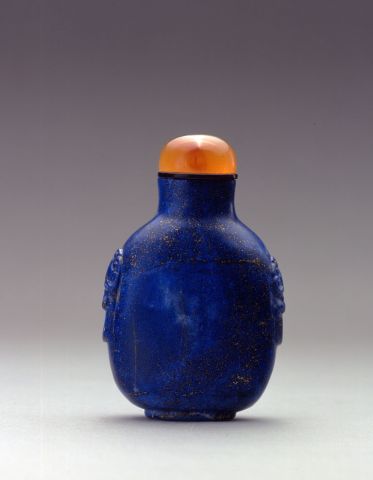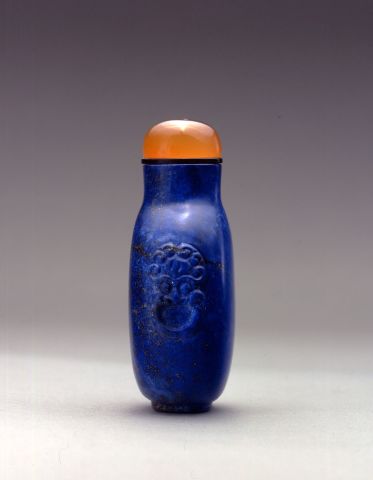

Bottle ID: 495
LAPIS LAZULI
Date: 1750-1850
Height: 51 mm
Lapis lazuli, well hollowed, of vivd blue tones, of small flattened ovoid form, with rounded shoulders sloping to a neck with slightly everted mouth and with a neatly carved footrim, the sides carved with mock mask and ring handles.
Possibly imperial, attributed to the Palace Workshops.
Similar Examples:
Crane Collection no. 741
Stevens, Bob C. The Collector's Book of Snuff Bottles, 1976, pp. 168-169, nos. 630 and 631.
Kleiner, Robert. Chinese Snuff Bottles - The White Wings Collection, 1997, p. 196, no. 136.
Low, Denis S. K. More Treasures from the Sanctum of Enlightened Respect, 2002, p. 264, no. 243.
Provenance:
Asian Art Studio
Peter and Marion Bozzo
Older lapis lazuli bottles are rare, but are generally of a smaller size as in the case of this example. Both this bottle and the one cited from the collection of Denis Low were left unadorned, but by stylistic comparison with plain nephrite bottles with the same dating, a possible imperial attribution may be given. Denis Low compares his bottle to a set of five matched white nephrite bottles in the National Palace Museum, which also houses eight lapis lazuli bottles of a similar strong color tone. Lapis lazuli has been mined in the remote Badakhshan Province of northeastern Afghanistan for over 6,000 years and was brought into China along the Silk Road. As a stone it was extremely important to Buddhism both for its bright color and its healing effects. It is highly symbolic of that which is sacred, pure or rare and is the given color of the principal Medicine Buddha. In one of the major sutras concerning this Buddha, Shakyamuni tells his close disciple Ananda:
I beseech you, Blessed Medicine Guru,
Whose sky-colored, holy body of lapis lazuli
Signifies omniscient wisdom and compassion
As vast as limitless space, Please grant me your blessings.

 English
English 中文
中文